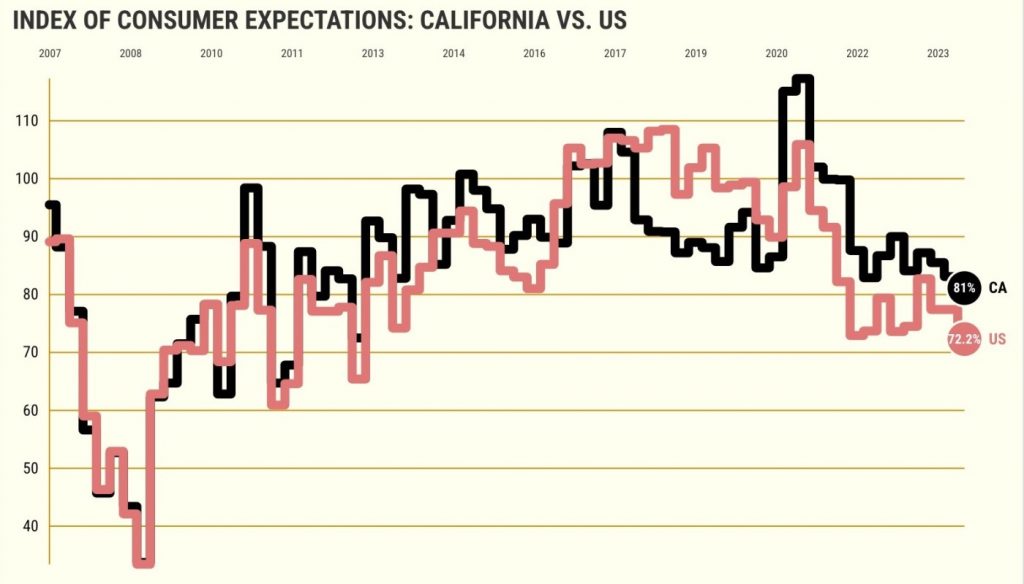The last time California consumers were this worried about their financial futures, the statewide median-priced home cost $379,000.
You have to go back to 2013’s first quarter to find a time when the measure of “expectations” within the Conference Board’s California consumer confidence index was lower than 2024’s second quarter average.
Yes, that’s just a little over 11 years ago. When the nation was still shaking off Great Recession rust. When the Dow Jones stock index hit 14,254 – recouping all its global financial crisis losses. When California’s unemployment rate was down to the 9% range – the best in four years.
My trusty spreadsheet’s quarterly averages of confidence data found California expectations dropping 5% in the past year. And there’s been plenty to worry about at mid-year 2024 – from political tension, nationally and globally, to high-profile job losses to a Federal Reserve determined to cool the economy and whip inflation with higher interest rates.
Don’t forget that shoppers who are nervous about the future typically are more than another economic data point. Skittish consumers don’t spend robustly. And that can further damage the business climate.
Curiously, California consumers feel the current economy is marginally OK despite all the challenges. The “present situation” slice of the index for spring 2024 was off only 1% in a year to its lowest reading since March 2021, just as pandemic lockdowns were ending.
And the combination of these two optimism markers shows overall confidence is off 3% in a year to the lowest since December 2020.
Note that it’s not just Californians with monetary anxieties.
Expectations nationwide also haven’t been this bad since 2013. Yet, US consumers’ view of the present situation is only at a six-month low. So that adds up to overall confidence nationwide dropping to a two-year low.
Spending surge?
What folks tell pollsters like those who create confidence indexes – and what consumers actually do – aren’t always the same thing.
For example, my spreadsheet found cash registers at California merchants were ringing more frequently in early 2024.
Statewide retail sales, minus online shopping, as measured by the Census Bureau averaged 1.4% annual growth in the six months ended in February. That’s a reversal from a shopping decline at a 0.5% annual rate in the previous half-year.
The spending rebound was aided by continued job growth, moderating inflation and heavier credit card use. Plus, less spending at gasoline stations thanks to falling pump prices – fuel sales are down at a 9% annual rate – was welcome news to other shopkeepers.
So where were Californians actively shopping?
Some pandemic shopping hot spots remain popular. Health goods and personal care stores’ sales rose at a 6.7% annual rate through February.
“Miscellaneous” retailers – including pet stores and second-hand shops – were up at a 5.9% rate. And general merchandise stores – giant discounters to dollar shops – rose 4.3% as bargain-hunting remained a passion.
Other merchants shook off coronavirus challenges. Electronics and appliance stores, weak after lockdowns ended, rebounded at a 4.6% annual rate. Car dealers, which finally had inventory to sell, saw sales up at a 6.3% rate. And another broad category – sports, hobbies, music and books – eked out a tiny 0.8% increase.
Others slumped, notably retailers tied to the death of home improvement’s surge.
So sellers of furniture and furnishings saw sales dive 10.4%. Merchants peddling building and garden goods were off 0.5%.
Clothing dipped 1.5% as the limited back-to-the-office push keeps folks in informal wear.
And food and beverage stores lost 2.5% as consumers look in other places for grocery bargains.
Price to pay?
Related Articles
Golden Gate Bridge tolls, fares set to increase today
‘I’m playing the lottery twice a week’: Newark councilman resigns, says he’s priced out of town
A California woman fought remodel evictions for years. Now she’s the one being evicted
10% of California credit card debt is late, 12th-highest delinquency rate in US
Federal Reserve’s preferred inflation gauge shows price pressures easing further
Perhaps some of the economic tensions stem from Californians last year aggressively using their plastic to keep on shopping.
Golden State credit card balances at the end of 2023 were equal to $4,450 per resident, says the New York Fed. That’s the 11th-highest card usage among the states.
But to my spreadsheet, it’s the jump in the balances that’s eye-catching – up 34% in two years. Equally stunning: That surge was only the 20th-biggest leap nationwide.
You see, Californians are not the only Americans swiping more. Credit-card users nationwide had balances of $3,950 per capita in 2023, up 29% in two years.
Credit card usage has surged as consumers spent the last of their pandemic-era stimulus funds and inflation rapidly raised the cost of daily life.
What’s most worrisome is that paying those plastic debts also became a challenge.
At year-end 2023, 10.23% of California credit card balances were 90-days late or worse, the 12th-highest delinquency rate in the nation. And that tardiness grew by 2.33 percentage points from 7.9% a year earlier, the No. 8 jump among the states.
Nationwide, 9.66% of card balances were delinquent last year – up 2.13 percentage points in 12 months.
By the way, the last time California’s skipped card payments were higher – before the pandemic – was 2013.
Back when Taylor Swift’s “I Knew You Were Trouble” was topping the charts, the “WIzard of Oz” prequel “Oz the Great and Powerful” was No. 1 at the box office, and the 17th season of “The Bachelor” was must-watch TV.
Jonathan Lansner is the business columnist for the Southern California News Group. He can be reached at [email protected]


